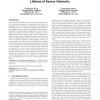Free Online Productivity Tools
i2Speak
i2Symbol
i2OCR
iTex2Img
iWeb2Print
iWeb2Shot
i2Type
iPdf2Split
iPdf2Merge
i2Bopomofo
i2Arabic
i2Style
i2Image
i2PDF
iLatex2Rtf
Sci2ools
CODES
2007
IEEE
2007
IEEE
On the impact of manufacturing process variations on the lifetime of sensor networks
As an emerging technology, sensor networks provide the ability to accurately monitor the characteristics of wide geographical areas over long periods of time. The lifetime of individual nodes in a sensor network depends strongly on the leakage power that the nodes dissipate in the idle state, especially for low-throughput applications. With the introduction of advanced low power design techniques, such as sub-threshold voltage design styles, and the migration of fabrication processes to smaller technology generations, variability in leakage power dissipation of the sensor nodes will lead to increased variability in their lifetimes. In this paper, we analyze how this increased variability in the lifetime of individual sensor nodes affects the performance and lifetime of the network as a whole. We demonstrate how sensor network designers can use the proposed analysis framework to trade-off the cost of a sensor network deployment with the performance it offers. Our results indicate th...
| Added | 02 Jun 2010 |
| Updated | 02 Jun 2010 |
| Type | Conference |
| Year | 2007 |
| Where | CODES |
| Authors | Siddharth Garg, Diana Marculescu |
Comments (0)

